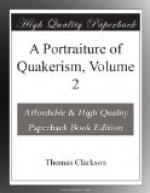The Quakers believe, that Jesus Christ was man, because he took flesh, and inhabited the body prepared for him, and was subject to human infirmities; but they believe also in his Divinity, because he was the word.
They believe also in the doctrine of the resurrection of the dead, as connected with the Christian religion. In explaining our belief of this doctrine, says Henry Tuke, we refer to the fifteenth chapter of the first epistle to the Corinthians. In this chapter is clearly laid down the resurrection of a body, though not of the same body that dies. “There are celestial bodies, and there are bodies terrestrial; but the glory of the celestial is one, and the glory of the terrestrial is another. So also is the resurrection of the dead: It is sown a natural body, it is raised a spiritual body: there is a natural body, and there is a spiritual body. Now this I say, brethren, that flesh and blood cannot inherit the kingdom of God; neither doth corruption inherit incorruption.” Here we rest our belief in this mystery, without desiring to pry into it beyond what is revealed to us; remembering “that secret things belong unto the Lord our God; but those things which are revealed, belong unto us and to our children.”
The Quakers make but little difference, and not such as many other Christians do, between sanctification and justification. “Faith and works, says Richard Claridge, are both concerned in our complete justification.”—“Whosoever is justified, he is also in measure sanctified; and as far as he is sanctified, so far is he justified, and no farther. But the justification I now speak of, is the making of us just or righteous by the continual help, work, and operation of the Holy Spirit.”—“And as we wait for the continual help and assistance of his Holy Spirit, and come to witness the effectual working of the same in ourselves, so we shall experimentally find, that our justification is proportionable to our sanctification; for as our sanctification goes forward, which is always commensurate to our faithful obedience to the manifestation, influence, and assistance, of the grace, light, and spirit of Christ, so shall we also feel and perceive the progress of our justification.”
The ideas of the Quakers, as to justification itself, cannot be better explained than in the words of Henry Tuke before quoted: So far as remissions of sins, and a capacity to receive salvation, are parts of justification, we attribute it to the sacrifice of Christ; “In whom we have redemption through his blood, the forgiveness of sins, according to the riches of his grace.” But when we consider justification as a state of divine favour and acceptance, we ascribe it, not simply either to faith or works, but to the sanctifying operation of the spirit of Christ, from which living faith and acceptable works alone proceed; and by which we may come to know, that “the spirit itself beareth witness with our spirits, that we are the children of God.”




